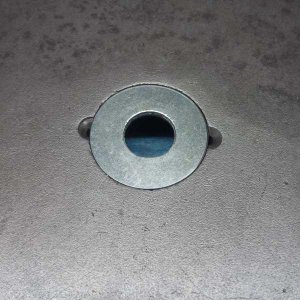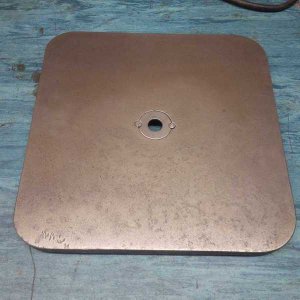-
Welcome back Guest! Did you know you can mentor other members here at H-M? If not, please check out our Relaunch of Hobby Machinist Mentoring Program!
- Forums
- GENERAL TYPES OF METALWORKING MACHINES
- ANTIQUE & VINTAGE MACHINERY
- MISC ANTIQUE & VINTAGE MACHINERY
You are using an out of date browser. It may not display this or other websites correctly.
You should upgrade or use an alternative browser.
You should upgrade or use an alternative browser.
Harvey Butterfly Die Filer Rebuild
- Thread starter ndnchf
- Start date
I've been thinking about a way to stem oil leakage from the lower spindle bore. In the photo in post #10 above, you can see how the spindle runs up/down in the housing. The housing has about 3/4" of oil in it, but there is no oil seal of any kind on the lower spindle, so it just seeps out the bottom, requiring the oil to be checked and topped off frequently. I'm thinking about cutting a groove in the lower spindle for an O-ring to help stem the flow. The bore looks pretty good and the fit its pretty tight, but I'd need to polish the bore to reduce O-ring wear. What do you guys think ?
Other progress. I've been stripping off the old paint and rust on the various parts. The table was pretty rusty, so I soaked it in Evaporust overnight, which removed all the rust. The table is missing the spindle cover, so I need to make one. I started last night by selecting a large washer with a 1-3/4" OD. I turned the OD down to 1-5/8" to fit the table. It was already the correct thickness - 1/8". Next I need to drill/file out the notches for the two retaining screws. I may need to open the ID a little, but I'll see how the files fit after its back together and adjust as necessary.

Other progress. I've been stripping off the old paint and rust on the various parts. The table was pretty rusty, so I soaked it in Evaporust overnight, which removed all the rust. The table is missing the spindle cover, so I need to make one. I started last night by selecting a large washer with a 1-3/4" OD. I turned the OD down to 1-5/8" to fit the table. It was already the correct thickness - 1/8". Next I need to drill/file out the notches for the two retaining screws. I may need to open the ID a little, but I'll see how the files fit after its back together and adjust as necessary.

I finished de-rusting the table and making the spindle cover this morning. I had to hand file/grind the countsunk holes for the cover screws. Not quite as nice as the missing original piece, but it will serve the purpose.

I've read that a lot of guys think this machine runs too fast with the original 1725 rpm motor. For a production shop where speed is important and files were easy to replace, I can understand the need for speed. But I don't need high speed. So I bought 1075 rpm motor off ebay to slow it down a bit. While I'm waiting, I'll continue to clean parts and get them ready for painting when the weather warms up. I still need to decide on the color too.

I've read that a lot of guys think this machine runs too fast with the original 1725 rpm motor. For a production shop where speed is important and files were easy to replace, I can understand the need for speed. But I don't need high speed. So I bought 1075 rpm motor off ebay to slow it down a bit. While I'm waiting, I'll continue to clean parts and get them ready for painting when the weather warms up. I still need to decide on the color too.
- Joined
- Mar 19, 2014
- Messages
- 2,680
You now have steel against steel. Please be mindful of the potential for galling.
- Joined
- Jul 26, 2011
- Messages
- 4,142
I have 3 die filers. The Butterfly is the one I use the most,as it is quick to set up. I STRONGLY URGE you to put a variable speed motor on yours,like I did. 1/2 H.P. is more than enough.
All these die filers run WAYYYYY too fast,which wears out the files very quickly. Also,the fast speed snaps small parts down on your finger tips. We had some women in my wife's jewelry shop,who needed to use the die filer,but after a few finger snaps were afraid of it. SOOOOO much more pleasant and controllable with a variable speed motor running MUCH slower. You can find cheap
speed controllers on Surplus Sales. Or,go to the PENN STATE catalog and they sell a small 1/2 H.P. mini lathe motor with controller for $115.00. It is powerful enough for this job,and pretty cheap.
The files are too expensive to be wearing them out. For the most part,before I got a bunch of die filer files,I have used a COARSE 6" half round Nicholson file. Grind the tang off. I don't want to ever get poked in the eye!! I ground the edges down some,too,so the front end of the file would go into the chuck. This file works very well for most work,and can be turned around to use the round side. Slowing the file down has greatly increased the file's life.
All these die filers run WAYYYYY too fast,which wears out the files very quickly. Also,the fast speed snaps small parts down on your finger tips. We had some women in my wife's jewelry shop,who needed to use the die filer,but after a few finger snaps were afraid of it. SOOOOO much more pleasant and controllable with a variable speed motor running MUCH slower. You can find cheap
speed controllers on Surplus Sales. Or,go to the PENN STATE catalog and they sell a small 1/2 H.P. mini lathe motor with controller for $115.00. It is powerful enough for this job,and pretty cheap.
The files are too expensive to be wearing them out. For the most part,before I got a bunch of die filer files,I have used a COARSE 6" half round Nicholson file. Grind the tang off. I don't want to ever get poked in the eye!! I ground the edges down some,too,so the front end of the file would go into the chuck. This file works very well for most work,and can be turned around to use the round side. Slowing the file down has greatly increased the file's life.
Last edited:
Thanks for your advice George. I've read your same comments on other die filer threads. While I did not get a variable speed motor, I did find an inexpensive 1/3 hp, 1075 rpm motor. This will slow it down quite a bit from the original 1725 rpm motor. But if I find it to still be too fast, I'll look into a variable speed motor. The machine is coming along nicely. I'm just finishing up painting all the parts and will start reassembly in a couple days.
- Joined
- Jul 26, 2011
- Messages
- 4,142
NDNCHF,you will find that the die filer still is going to run way too fast,even with your somewhat slower motor. The speed reduction needed far exceeds what your new motor will do,believe me. I know!!
Those little mini lathe motors that Penn State sells for mini lathes used for turning out writing pens( HOW many pens can this country absorb???) look like they will work nicely,though you'll have to make a cradle to mount the motor in. A wooden one will do if you don't want to spend a lot of time on it.
Anyone who uses the Penn State motor ought to report how successful the motor was. Those motors,I just realized,probably run 3450 RPM in normal speed. I HOPE they work o.k. if their speed is cut by 3/4 speed,or so. A gear or 2 added in would help a lot to preserve the motor's strength. Should have thought of that in my previous post. Pain meds don't help!! I happened to get a larger,but still 1/2 H.P. motor from a used machinery place. A reduction gear head motor would work,but I can't tell you the speed needed off the cuff.
Those little mini lathe motors that Penn State sells for mini lathes used for turning out writing pens( HOW many pens can this country absorb???) look like they will work nicely,though you'll have to make a cradle to mount the motor in. A wooden one will do if you don't want to spend a lot of time on it.
Anyone who uses the Penn State motor ought to report how successful the motor was. Those motors,I just realized,probably run 3450 RPM in normal speed. I HOPE they work o.k. if their speed is cut by 3/4 speed,or so. A gear or 2 added in would help a lot to preserve the motor's strength. Should have thought of that in my previous post. Pain meds don't help!! I happened to get a larger,but still 1/2 H.P. motor from a used machinery place. A reduction gear head motor would work,but I can't tell you the speed needed off the cuff.


